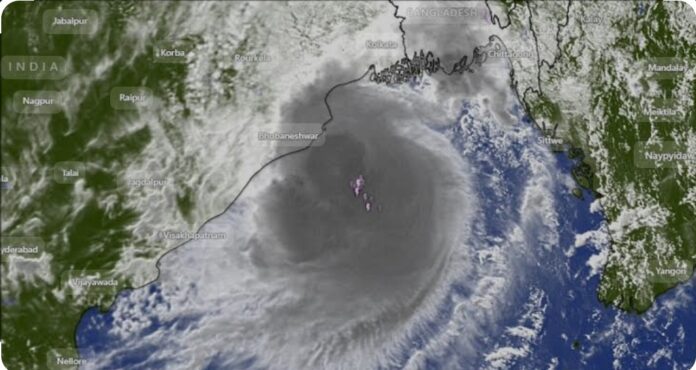What is Cyclone Dana?
Cyclone Dana is a weather phenomenon characterized by a powerful low-pressure system that can cause severe storms, heavy rainfall, and strong winds. The term “Dana” comes from the Spanish acronym “Depresión Aislada en Niveles Altos,” meaning “Isolated Depression at High Levels.” It describes a situation where cold air at higher altitudes descends and meets warmer surface air, creating atmospheric instability. When this phenomenon occurs over warm ocean waters, it can intensify into a cyclonic storm, bringing significant weather impacts similar to those of tropical cyclones. Although DANA is not a cyclone in the traditional sense, it can still produce cyclonic effects, such as intense rainfall and flooding, especially in coastal areas.
How Does a Cyclone Form?
Cyclones develop when certain atmospheric conditions are met, typically over warm ocean waters. The process involves the following stages:
- Warm Ocean Water: The primary source of energy for a cyclone is warm sea surface temperatures, usually above 26°C (79°F). This heat causes water to evaporate, increasing humidity in the air.
- Low-Pressure Area Development: The warm, moist air rises, creating a low-pressure area near the ocean surface. As air continues to rise, it cools and condenses, releasing latent heat that further warms the air and causes it to rise more vigorously.
- Convergence and Rotation: As the air rises, more air from the surrounding areas converges toward the low-pressure center, creating a rotating effect due to the Earth’s Coriolis force. This rotation helps to organize the system into a circular structure.
- Intensification: If conditions remain favorable, with continued heat and moisture supply and minimal wind shear (changes in wind speed or direction at different altitudes), the cyclone intensifies. Wind speeds increase, and the central pressure drops, leading to a more organized storm structure.
- Landfall or Dissipation: When a cyclone makes landfall, it loses its primary energy source (warm ocean water) and begins to weaken. Alternatively, it can also dissipate if it encounters cooler waters or high wind shear.
What is DANA?
DANA, or “Depresión Aislada en Niveles Altos,” refers to an isolated cold air depression at high levels of the atmosphere. It often occurs when cold air from the upper atmosphere descends and meets warmer surface air, leading to significant atmospheric instability. Unlike tropical cyclones that form over warm oceans, a DANA can develop over land and typically affects regions like Spain and the Mediterranean. It can bring about intense storms, heavy rainfall, and flooding, with impacts similar to those of a cyclone but with different atmospheric dynamics.
How to Prepare Before a Cyclone
Proper preparation is crucial to ensure safety during a cyclone. Here are essential steps to take:
- Stay Informed: Monitor weather forecasts and official updates regularly. Use reliable sources, such as meteorological departments or weather apps, for live tracking of the cyclone’s path and intensity.
- Emergency Kit Preparation: Assemble an emergency kit with essentials such as water, non-perishable food, medications, first aid supplies, flashlights, batteries, and important documents. Make sure it is easily accessible.
- Secure Your Home: Reinforce windows, doors, and roofs to minimize damage. Secure loose objects in the yard that could become projectiles during strong winds.
- Evacuation Plan: Know your area’s evacuation routes and have a plan in case local authorities advise evacuation. Share the plan with family members to ensure everyone is aware of the steps to take.
- Charge Electronic Devices: Make sure mobile phones, power banks, and other communication devices are fully charged to stay connected during power outages.
- Avoid Flood-Prone Areas: If you live in a low-lying area prone to flooding, consider relocating to higher ground before the cyclone arrives. Avoid walking or driving through flooded areas during the storm.
- Stay Indoors: During the cyclone, stay indoors and keep away from windows and doors. Follow instructions from local authorities and do not venture outside until it is safe to do so.
Conclusion
Cyclone Dana, influenced by the DANA phenomenon, can bring severe weather conditions that warrant careful monitoring and preparation. Understanding the formation process of cyclones, the characteristics of a DANA, and taking proactive measures can help reduce the risks associated with these powerful storms. Stay informed, prepare adequately, and follow safety guidelines to protect yourself and your property during a cyclone.
2024 aam admi party AAP AI america Anant Ambani Arvind kejriwal BJP BOLLYWOOD Bollywood news CHIEF MINISTER CONGRESS CRICKET FILM google Governance GUJARAT HEALTH History Hollywood INDIA INDIAN indian government Indian Leader IPL IPL 2024 jokes LIFESTYLE MOVIE REVIEW MUMBAI NARENDRA MODI pakistan PM Modi Radhika Merchant Ram mandir Ranbir Kapoor SOCIAL MEDIA SPORTS sports news summer season Technology trending trending news usa VIRAL NEWS







